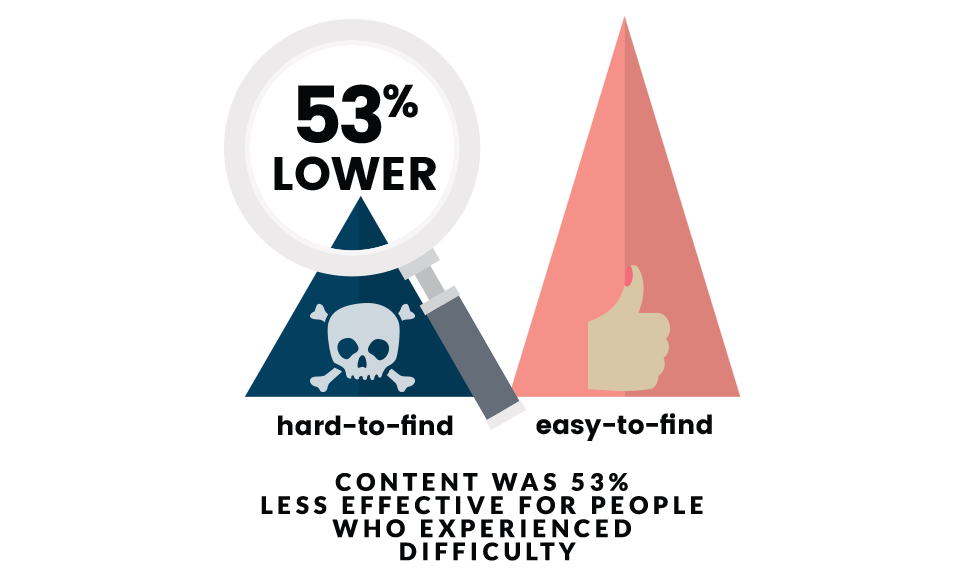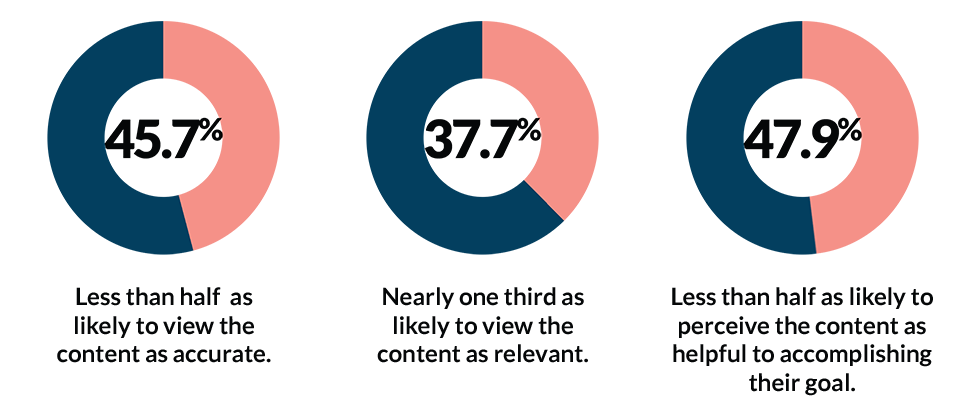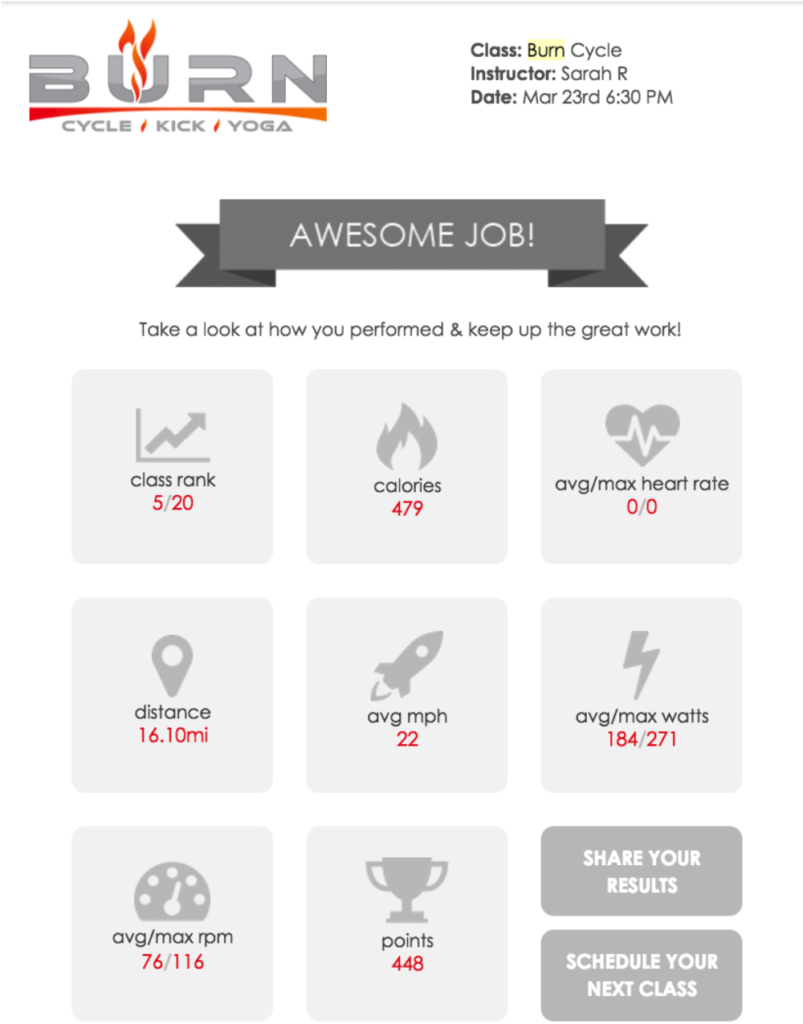
Content should be easy to find. Whether you’re a digital leader or someone who gets frustrated on the interwebs, that statement might sound … obvious. But research Content Science recently conducted reveals there’s much more at stake with making content findable than following a best practice or saving your customers a moment of frustration. When your customers struggle to find the right content from your organization, you kill the opportunity to connect with, influence, or support them. The impact is far more devastating than I ever would have imagined.
In this article, I explain our key insight about hard-to-find content and evidence of its disastrous consequences. Then, I share implications for making content easier to find.
Content Findability Drives Perception of the Content Itself
Let me briefly explain the method to our research madness at Content Science. It starts with data from ContentWRX, our software that evaluates content effectiveness across six dimensions:
- Discovery / findability
- Accuracy
- Usefulness
- Relevance
- Polish
- Influence
We took data collected from more than 160,000 content consumers and conducted a special analysis with this goal: To uncover new insights about content effectiveness that apply broadly, to any organization with content.
That’s when we discovered just how devastating hard-to-find content is to anything you hope to achieve with your customers, users, or audiences. If your customers perceive your content as difficult to find, that frustration distorts their perspective on the content itself. In other words, the negative impact doesn’t stop once your customers find the right content. The negativity lingers, causing your users to view the content as less accurate, less relevant, less useful, and less influential on helping them achieve their goal.
Let’s take a closer look at some proof and implications.
Content Findability Is a Lasting First Impression With High Stakes
When customers find your content but experience difficulty along the way, your content becomes significantly less effective. We found that content was 53% less effective for people who experienced difficulty finding it.

We found that when people perceived content as hard to find, they also seriously doubted its accuracy, relevance, and usefulness to their goal.

It might be helpful to explain this insight another way. If your customers had trouble finding your content but eventually did, they are
- Less than half as likely to view that content as accurate.
- Nearly one-third as likely to view that content as relevant.
- Less than half as likely to perceive that content as helpful to accomplishing their goal.

What this means is you could have the most amazing content ever, but if your users experience difficulty connecting with it, you’re fighting an uphill battle for their trust and engagement. You will not win their hearts or their minds.
If you’re a media company, you could offer award-worthy news or entertainment material, but your audiences will ignore or dismiss it if discovery is difficult.
If you’re another kind of business, you could develop truly insightful thought leadership, creative marketing campaigns, useful sales information, and helpful support, but your customers will be unmoved or dissatisfied if discovery is difficult.
If you’re a nonprofit, you could share insightful research, informed opinion, useful advice, and more, but your supporters and stakeholders will be unlikely to act if discovery is difficult.
Ouch. If you aren’t making your content findable, everything else about the content is for naught. And if you think about the fact that business today is digital and mediated by content, the stakes for content findability get high. Very high. If you can’t make your content findable, you likely will become one of the many organizations who become extinct because they can’t adapt to digital. In other words, they can’t achieve digital transformation. If more than half of the Fortune 500 can disappear, your organization can, too.
Let’s discuss implications to make your content more discoverable.
4 Ways to Avoid or Recover from Content Discovery Disaster
If you’re like most companies and organizations, you cannot afford the dire consequences of inadvertently leading customers on wild goose chases for your content. It’s time to modernize with a mix of new thinking and old hat best practices.
1. Bring the Content to the User / Customer
Reconsider whether it’s realistic to put the burden on your customers, users, or audiences to find your content. Are your customers really willing to wade through multiple levels of navigation or a set of search filters and settings so complex they look like a control center in a spaceship? Start thinking about how your company can take on the burden of connecting your customers with the right content. One of the most effective ways to do so is to embrace personalization. Think about how to Amazon-ify your content, such as
- Proactively offering your customers suggested content or information immediately when they visit your site.
- Showing your customers or users what content that other people with similar interests, needs, or other similarities found useful.
- Giving your customers suggestions for more content similar to the content they just consumed.
- Reminding or alerting customers of important decisions, tasks, and more.
- Customizing offers or messages based on your customers’ interests or status.
- Planning microcopy and contextual help to guide customers in the moment rather than make them look up instructions.
You can bring the content when users expect it … or when it will surprise and delight them. The Weather Channel released clever content delivery for sunny days; get all of the details in this useful article. Let me share a quick example from the health and wellness space. Have you ever attended a spinning class? I am a fan. When I tried a local Atlanta spinning studio called Burn, I was impressed. Although a single location, Burn was doing digital business better than most Fortune 500 companies.
- I buy a package of classes and create a basic profile on the website.
- When I want to attend a class, I register and also select my preferred bike.
- I receive an email confirmation and then an email reminder about my class.
- When I enter the studio for the class, I check in using a kiosk.
- During the class, I can see all of my statistics on a screen at the front of the room as well as my rank compared to other class attendees.
All good, right? Here is the kicker. Immediately after my first class, I receive this email.

I said, “Wow.”
And my website profile with Burn immediately became anything but basic. It was a useful source of exercise and performance data that I could check anytime. I wasn’t surprised to read last week that Burn is opening a second location soon.
To pull off personalization, you need data such as your customers’ behavior or history and preferences. You also need your content to be ready for delivery in new ways, which leads us to number 2.
2. Code Content to Drive Sophisticated Delivery and Artificial Intelligence
To personalize content delivery as well as deliver content efficiently across channels, touchpoints, and devices, your content needs coding. Your content management system or content marketing platform or artificial intelligence solution (such as a chat bot) doesn’t magically make that happen.
This coding starts essentially with modeling what content types and components need to be available where. This coding continues with engineering a system of logic, taxonomy, and metadata that will execute what you modeled.
If you’re getting further into artificial intelligence, such as natural language generation or automated optimization driven by machine learning, then you also will need to engineer rules and logic about your content voice, style, compliance requirements (in regulated industries), and more. You need those rules to teach your artificial intelligence, or else you risk experiencing a disaster like Microsoft’s bot Tay, which quickly learned how to be a racist Twitter troll.
And if your company has documented voice, style, content types, and similar information all along, you’re 10 steps ahead of most organizations. That documentation is a great starting point for the rules and logic needed to teach your machines how to create or optimize your content.
Coding your content is not a light effort. IDC predicts that by 2027 spend on digital transformation will reach $4 trillion, and much of that work involves information (or content) transformation. Would it make sense to invest in this effort for content that is not updated or performing well? That brings us to item 3 …
3. Delete Outdated and Underperforming Content — Seriously!
Just as you might tire of incentivizing your children (or your roommate or spouse) to clean up their stuff, I sometimes tire of pointing this out. But this best practice is more important than ever. And too many companies and organizations are still not following it, even as they experiment with generative AI at scale. So, it bears repeating. Get rid of outdated and underperforming content. Doing so is now critical to making the rest of your organization’s content findable. Let me explain.
If your company continues to clog its digital presence with content that no longer works, your company
- Reduces the chances that your customers will discover the most appropriate content. You’re making your customers look for a needle in a haystack.
- Risks that your customers will mistakenly use content that is outdated or inaccurate, which can lead to confusion, unrealistic expectations, and serious errors—all of which can lead to returned purchases, customer churn, lawsuits, and lost trust.
- Risks looking like one of those organizations that doesn’t care. The outdated content might not cause a major problem right away, but it immediately undermines your customers’ confidence and trust in you. If you can’t keep your content current, why should customers believe you can handle their business or advise them on high-stakes topics such as health?
After considering the above, ask yourself or encourage your stakeholders to ask themselves … can we really treat keeping our content current as optional? Can we really afford to keep making excuses? I encourage you to view maintaining current content as a must-happen best practice, or your company’s investment in 1 and 2 above will not matter. It’s like trying to improve your health with a fancy gym, expensive personal trainer, and nifty equipment—without trimming excessive junk food from your diet. It doesn’t work, not to mention wastes your time and money.
For a remarkable example of wrangling an out-of-control proliferation of content, check out this article about Intel’s efforts. And also learn how AI can be part of the solution.
So 3 has taken us to an old-school best practice. Now, let’s go to a very new-school place.
4. Embrace Modern Content Roles
Achieving 1-3 above requires roles that for many companies and organizations will be new. A writer / editor or even a content strategist alone cannot achieve the above. For starters, you need people to analyze the content, its performance data, and its structure; people to plan the logic, define the metadata, and maintain both; people to plan the experience of consuming the content; and people to define and enforce governance of content. Sound overwhelming? Consider this table as a starting point for embracing the roles you need.
| Recommendation | Roles Needed |
|---|---|
| 1 Bring the Content to the User | Content Strategist Content Designer Content Marketer |
| 2 Code Content | Content Analyst |
| Content Engineer | |
| 3 Delete Outdated and Underperforming Content | Content Analyst Content Strategist Content / Digital Governance Director |
If you work for an enterprise, these roles likely will be discrete jobs. If you work for a smaller organization, you might have people taking on more than one role, but likely not all of them in one job. Learn more about many of these roles in the article 4 Critical Content Roles for Digital Transformation and Beyond.
Content Findability: Do or Die
We covered much ground, old and new, in this article. I hope you feel a revived sense of urgency to make your organization’s content findable. For any organization that takes digital transformation seriously, the stakes are much higher than a minor inconvenience to your customers, users, or audiences. The choice is do the work to make your content discoverable or risk fading into digital oblivion like more than half of the Fortune 500 since 2000. I hope your company chooses to embrace the work—the way Intel, The Weather Channel and even Burn have—and to thrive as a digital business.
Events, Resources, + More
The Ultimate Guide to End-to-End Content
Discover why + how an end-to-end approach is critical in the age of AI with this comprehensive white paper.
The Content Advantage Book
The much-anticipated third edition of the highly rated book by Colleen Jones is available at book retailers worldwide. Learn more!
20 Signs of a Content Problem in a High-Stakes Initiative
Use this white paper to diagnose the problem so you can achieve the right solution faster.
Upskill with Content Science Academy
Training for modern content roles through on-demand certifications + courses or live workshops.






Comments
We invite you to share your perspective in a constructive way. To comment, please sign in or register. Our moderating team will review all comments and may edit them for clarity. Our team also may delete comments that are off-topic or disrespectful. All postings become the property of
Content Science Review.